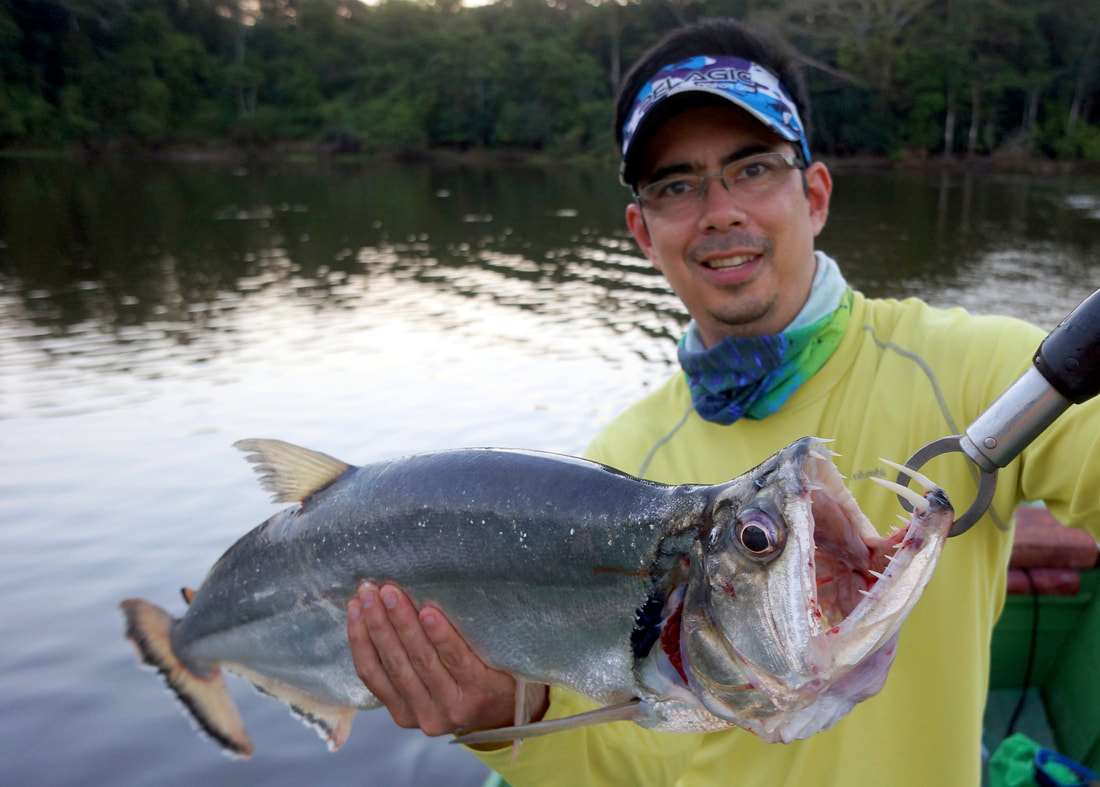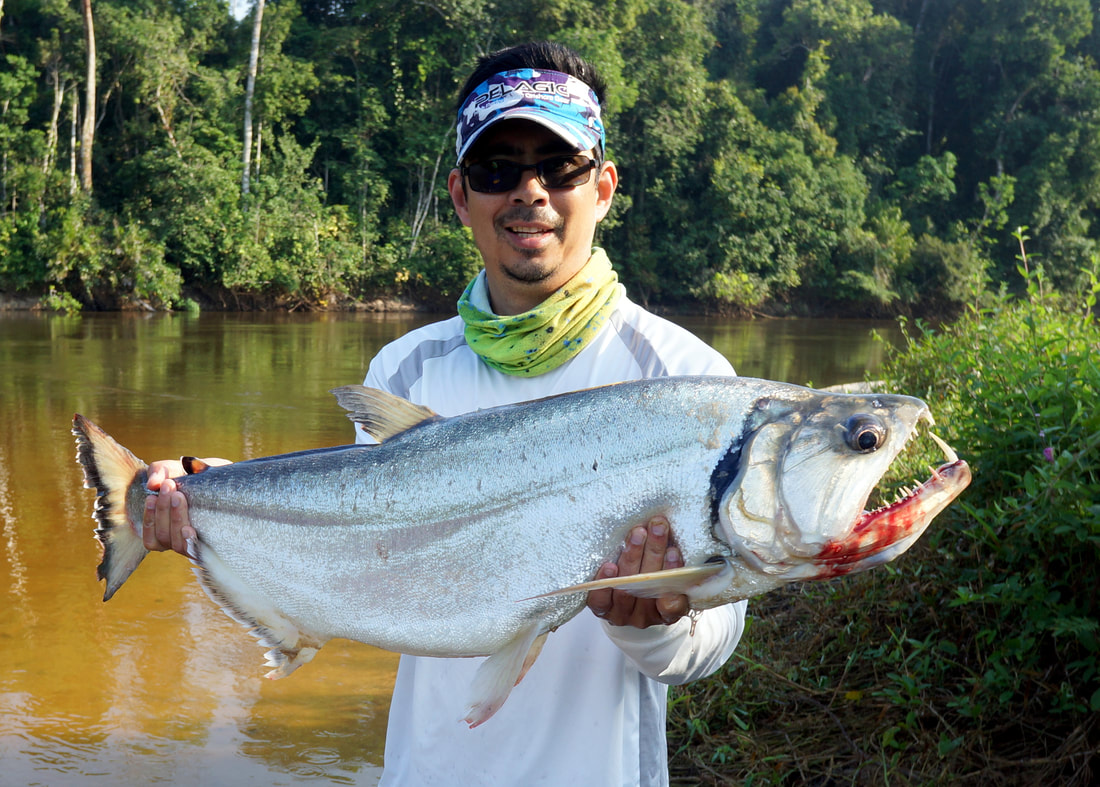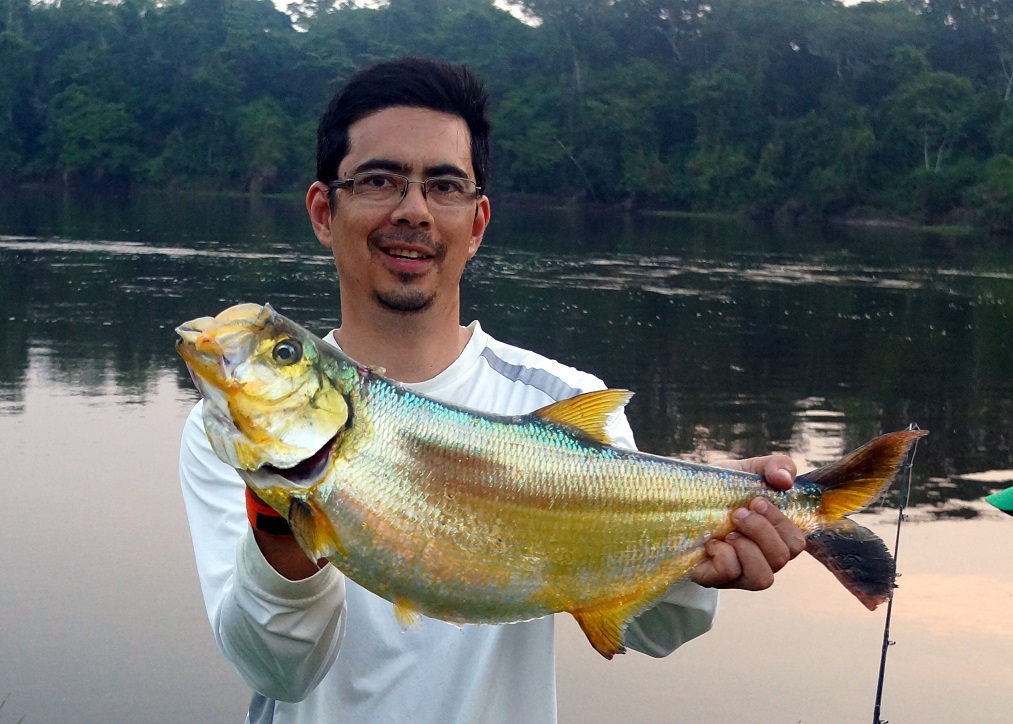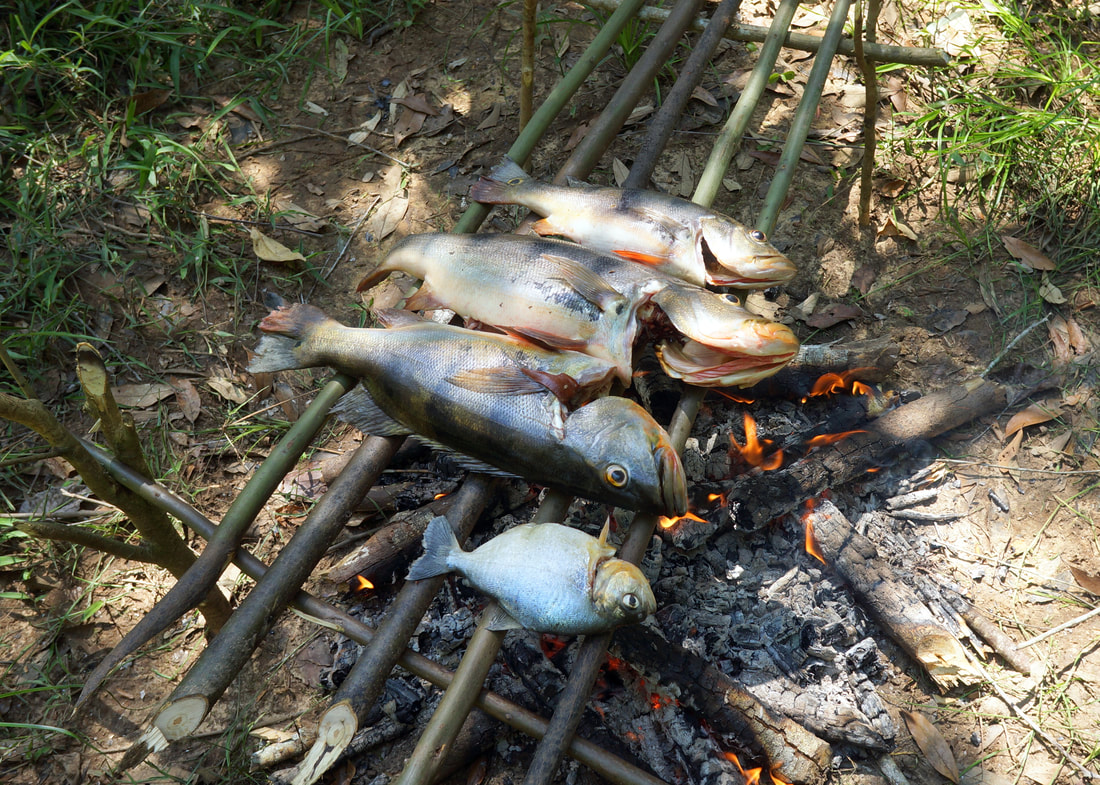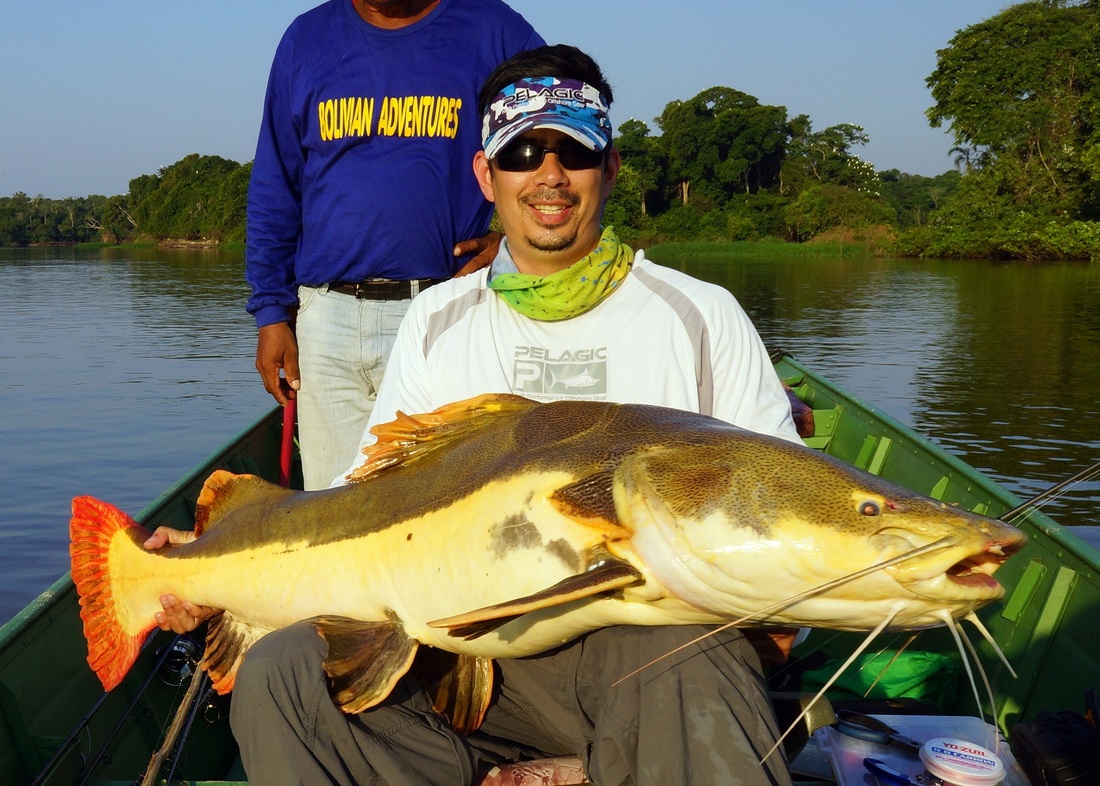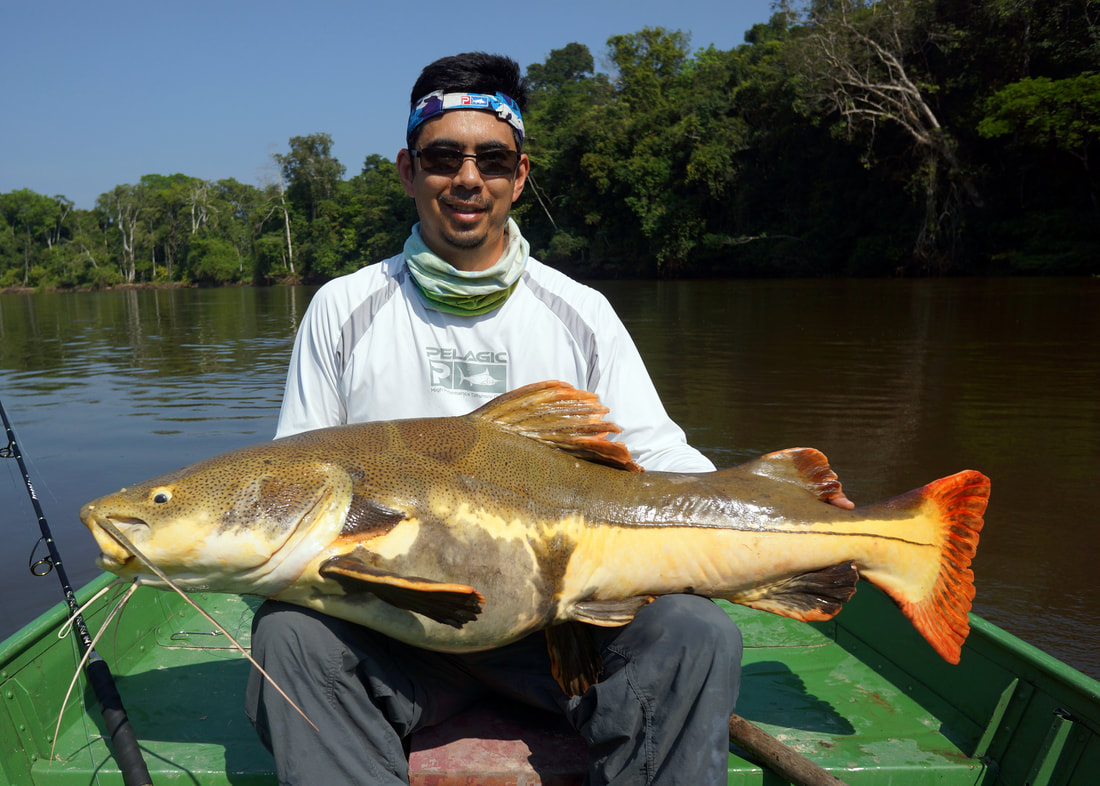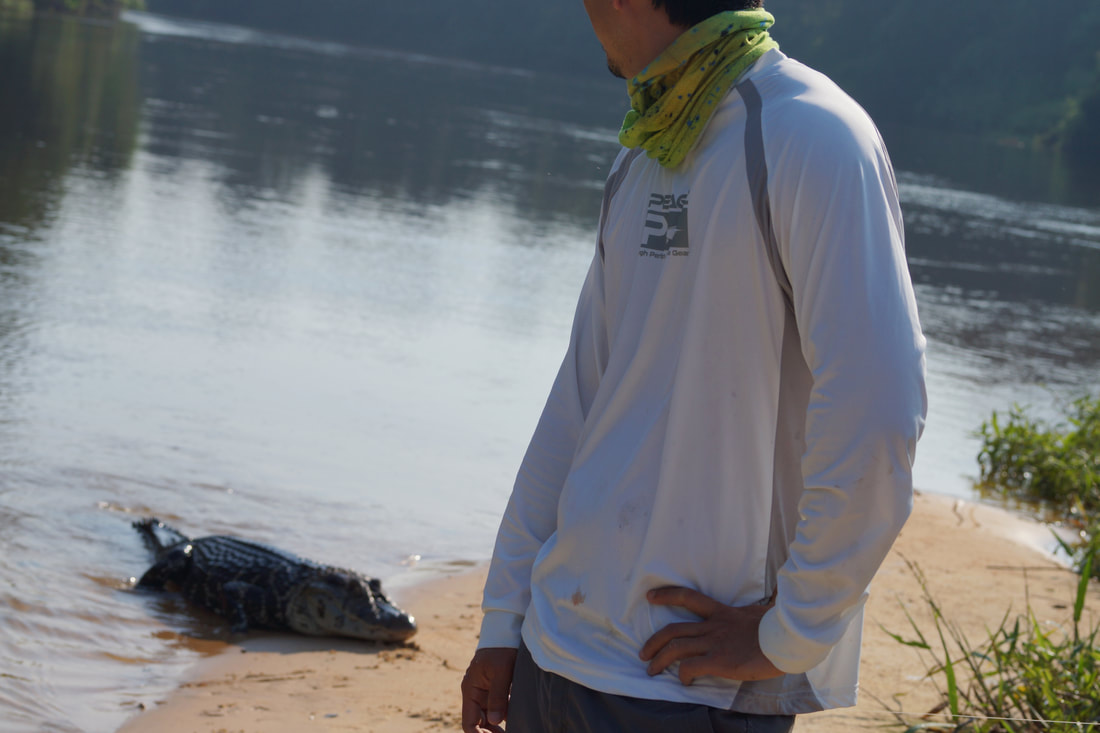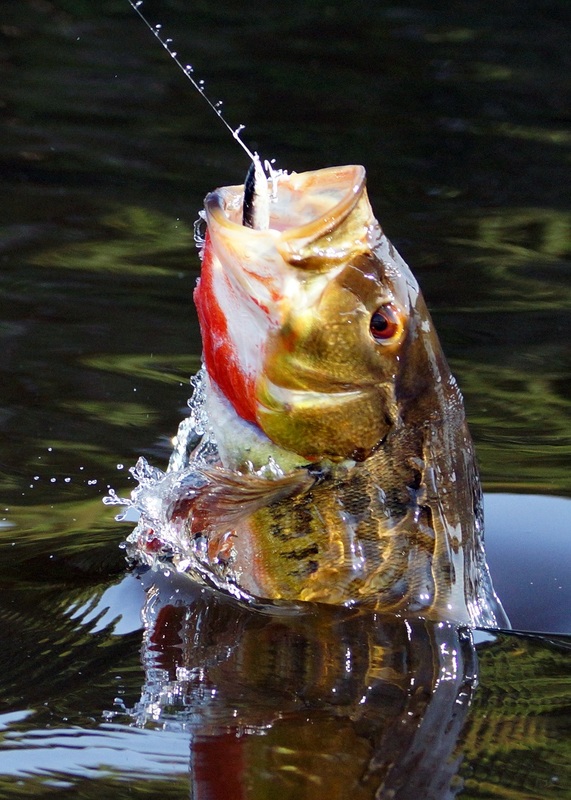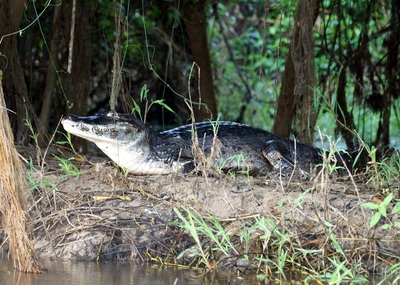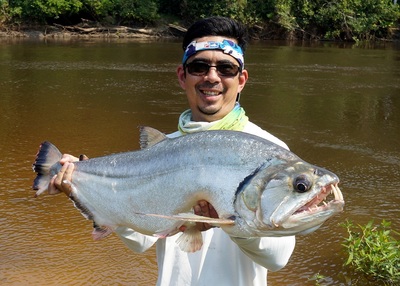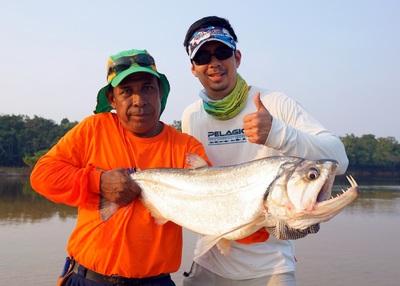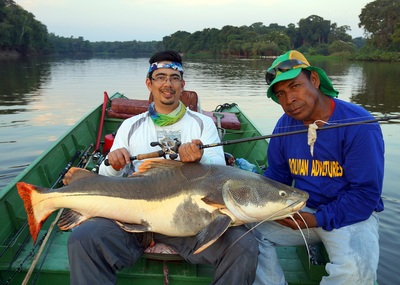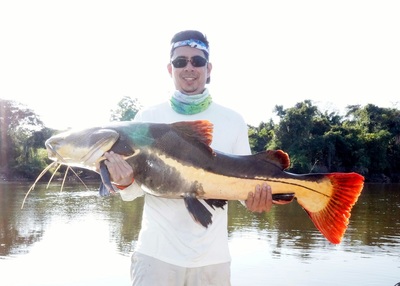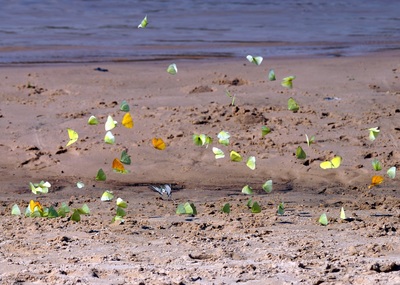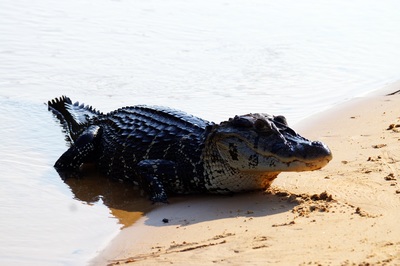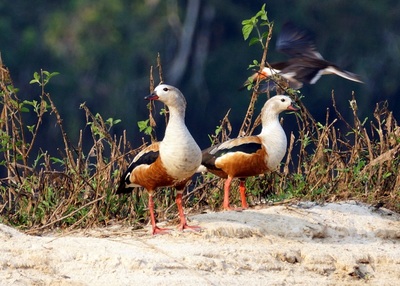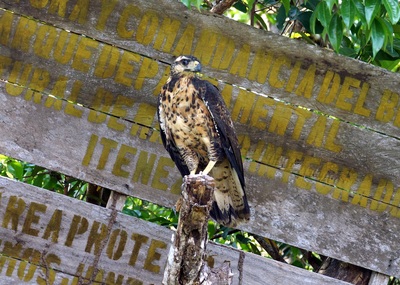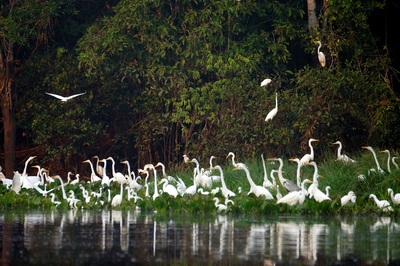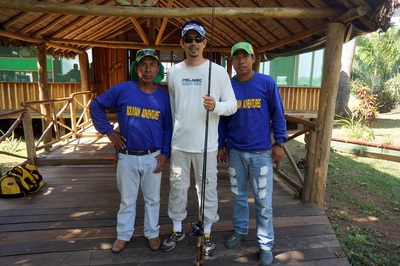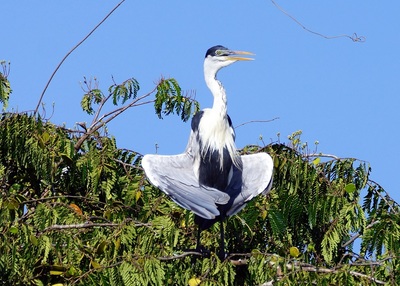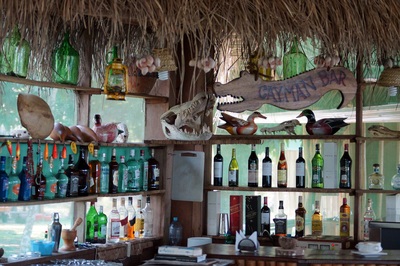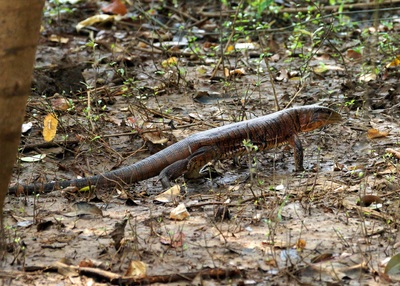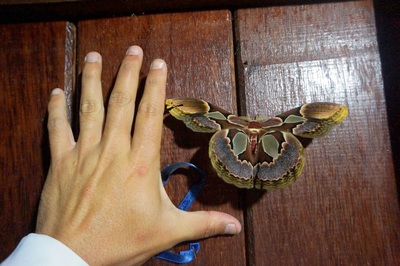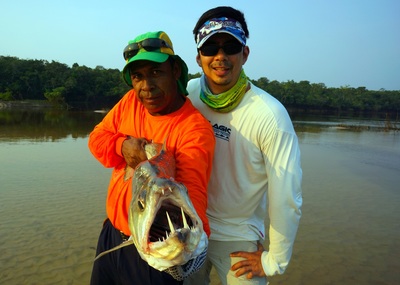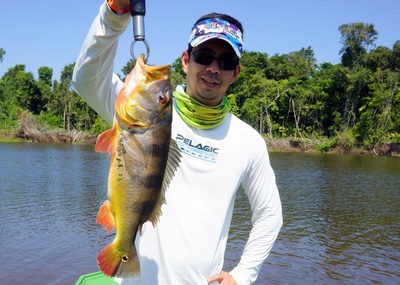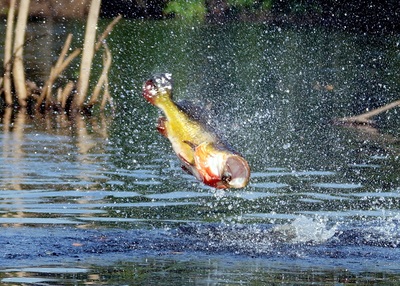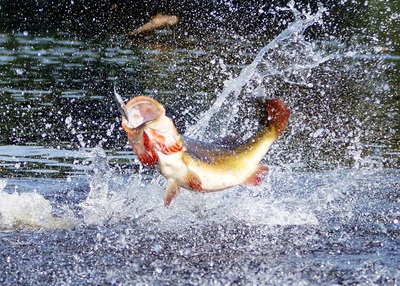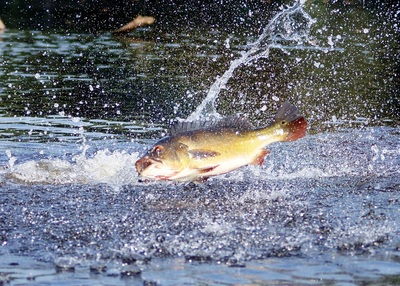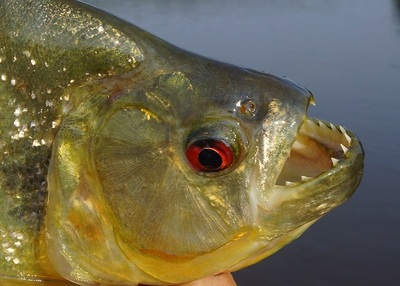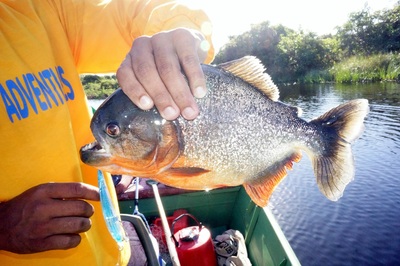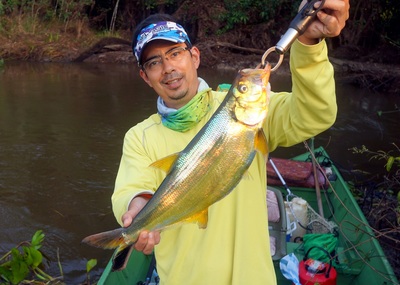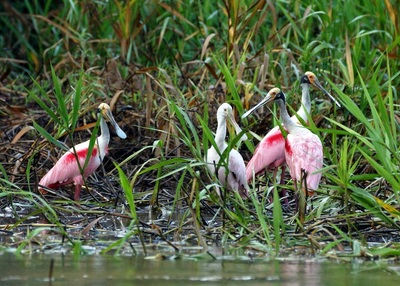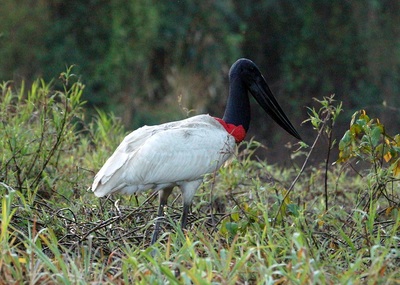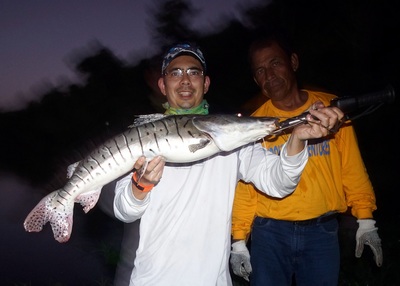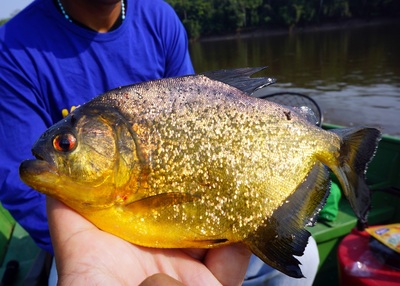Cano Negro, Bolivia
August 2015
Species: Payara, Peacock Bass, Redtail Catfish, Sardinata, Piranha, Suribim Catfish
I have been trying to catch the Payara or Vampire Fish for many years. I went to high school in Venezuela and first learned about them there but never had a chance to fish for them. I went to a place in Brazil that had some a few years ago but had no luck. I heard about the Cano Negro Lodge in Bolivia from someone I met in Brazil and he had some pictures of some nice Payara so a couple years later I was able to book a trip.
The trip out there was no joke; 5.5 hours to Miami, 6.5 hours to La Paz, Bolivia (where strangely it was snowing), 1.5 hours to Santa Cruz, Bolivia (where thankfully it was not snowing) and then a 2 hour charter flight to the lodge on the Bolivia/Brazil border. Plus all the airport time between flights. That was a long stretch of travel to do without any break (about 20 hours total) but anticipation was so high that I immediately wanted to go fish after getting off the plane. That first afternoon was spent casting lures near the lodge for peacock bass, of which I caught 12 up to 5lbs or so along with about 10 piranha and a couple random species.
The Cano Negro Lodge is built right on the banks of the river and is the only structure for quite a few miles in any direction. They have a couple cabins and some tents. I got a cabin all to myself since the lodge was not very full. There were two other Americans who came in the little plane with me and a few Columbians staying at the lodge. The Columbians left mid-week so it was just the 3 of us after that. That made for a very high staff to guest ratio so we were well attended.
One of the highlights of the lodge is the abundant wildlife. I had taken two other Amazon trips to remote areas in Brazil in the past and this place had far more wildlife. I think it is partly due to the fact that the water levels fluctuate less here than in the Brazil fisheries. Every morning on the way out we would see hundreds of birds of many different species, some of which I was familiar with and some of which I was not. There were also quite a large number of crocodiles, alligators, and impressive Black Caiman. The alligators were fairly shy and kept to themselves, but some of the Caiman were quite aggressive. More on that later. Some of the other interesting wildlife I saw on the trip included giant river otters, pink river Dolphins, various stingrays, a few electric eels, a big monitor lizard, Hawks, Eagles, egrets, parrots, storks, and tons of different fish. I really wanted to see a jaguar as I have never seen one, and I saw some fresh jaguar tracks as well as a recently dead jaguar, but did not get to see a live one. From what I understand, if they don't want to be seen they could get within 5 feet of you and you wouldn't know it.
The Payara was the main reason I was in Bolivia and that is where I concentrated my efforts. They are a difficult fish to catch for a number of reasons. To start with, there are not a ton of them around although there were a couple spots where they were somewhat concentrated. They have excellent eyesight which makes them hard to fool especially with lures. They generally only bite well in low light conditions in the morning and late afternoon. Their strike is often extremely quick and they will grab the lure or bait and then drop it a half second later so if you are not constantly ready to set the hook you will miss them. It's hard to keep up that level of vigilance for hours on end especially when the strikes are few and far between. They have a very bony mouth and if you do get a good bite you have to set the hook several times as if your life depends on it in order to have a chance for the hook to stick. If you do manage to get a solid hookup, they will often leap and shake their heads and dislodge the hook. I lost a lot of solidly hooked fish at the net. They are also quite strong and broke my line on a couple of occasions. If you fish with too light of a drag you can't get the bone-jarring hook set you need, and if you fish with too heavy of a drag you risk breaking them off. After much experimentation I found the best approach was to fish with the drag completely buttoned down, set the hook hard 4-5 times, and then loosen the drag a bit for the fight. No matter what you do you are not going to land them all though.
The one thing working in your favor with Payara is that when they are active you will often see them rolling on the surface so at least you know they are there. Then you can camp out in the area and try several things until you find something that works. We fished a lot from shore on sandy beaches at bends in the river where the current was faster. We also sometimes anchored in the middle of the river or drifted. I would generally average 4-10 strikes per morning/afternoon session and land anywhere from 0 to 3 fish. Their challenging nature made each fish landed special, and I remember every strike and fight from the 12 Payara I landed for the week. They ranged from one tiny 1lber to a handful over 20lbs. The ones landed on lures averaged around 10lbs and the ones landed on bait averaged around 18lbs. Interestingly they didn't show any interest in bait unless it was constantly cast and retrieved like a lure.
One of my favorite fishing memories of my entire life was wading from a sandy island in the middle of the river and casting into a big school of rolling Payara. It was late in the day so the temperature was perfect, the bugs were surprisingly sparse, and the fish were biting on almost every cast. The fish were big and the casualty rate was high, but I did get two over 20lbs in the net along with one around 14lbs. Pink river Dolphins were frequently surfacing and feeding outside the school of Payara, and the serenity was constantly interrupted by schools of baitfish getting blasted against the shore by marauding schools of Peacock Bass all around me. On any other day I would have dropped everything to cast at those Peacock Bass, but this was not any other day so I stayed focused on the Payara. That evening I was constantly hooked up to big fish and the trophies that were landed made the trophies that got away easier to stomach. Of course on subsequent visits to the island it was a totally different story and I did not land another fish from there.
August 2015
Species: Payara, Peacock Bass, Redtail Catfish, Sardinata, Piranha, Suribim Catfish
I have been trying to catch the Payara or Vampire Fish for many years. I went to high school in Venezuela and first learned about them there but never had a chance to fish for them. I went to a place in Brazil that had some a few years ago but had no luck. I heard about the Cano Negro Lodge in Bolivia from someone I met in Brazil and he had some pictures of some nice Payara so a couple years later I was able to book a trip.
The trip out there was no joke; 5.5 hours to Miami, 6.5 hours to La Paz, Bolivia (where strangely it was snowing), 1.5 hours to Santa Cruz, Bolivia (where thankfully it was not snowing) and then a 2 hour charter flight to the lodge on the Bolivia/Brazil border. Plus all the airport time between flights. That was a long stretch of travel to do without any break (about 20 hours total) but anticipation was so high that I immediately wanted to go fish after getting off the plane. That first afternoon was spent casting lures near the lodge for peacock bass, of which I caught 12 up to 5lbs or so along with about 10 piranha and a couple random species.
The Cano Negro Lodge is built right on the banks of the river and is the only structure for quite a few miles in any direction. They have a couple cabins and some tents. I got a cabin all to myself since the lodge was not very full. There were two other Americans who came in the little plane with me and a few Columbians staying at the lodge. The Columbians left mid-week so it was just the 3 of us after that. That made for a very high staff to guest ratio so we were well attended.
One of the highlights of the lodge is the abundant wildlife. I had taken two other Amazon trips to remote areas in Brazil in the past and this place had far more wildlife. I think it is partly due to the fact that the water levels fluctuate less here than in the Brazil fisheries. Every morning on the way out we would see hundreds of birds of many different species, some of which I was familiar with and some of which I was not. There were also quite a large number of crocodiles, alligators, and impressive Black Caiman. The alligators were fairly shy and kept to themselves, but some of the Caiman were quite aggressive. More on that later. Some of the other interesting wildlife I saw on the trip included giant river otters, pink river Dolphins, various stingrays, a few electric eels, a big monitor lizard, Hawks, Eagles, egrets, parrots, storks, and tons of different fish. I really wanted to see a jaguar as I have never seen one, and I saw some fresh jaguar tracks as well as a recently dead jaguar, but did not get to see a live one. From what I understand, if they don't want to be seen they could get within 5 feet of you and you wouldn't know it.
The Payara was the main reason I was in Bolivia and that is where I concentrated my efforts. They are a difficult fish to catch for a number of reasons. To start with, there are not a ton of them around although there were a couple spots where they were somewhat concentrated. They have excellent eyesight which makes them hard to fool especially with lures. They generally only bite well in low light conditions in the morning and late afternoon. Their strike is often extremely quick and they will grab the lure or bait and then drop it a half second later so if you are not constantly ready to set the hook you will miss them. It's hard to keep up that level of vigilance for hours on end especially when the strikes are few and far between. They have a very bony mouth and if you do get a good bite you have to set the hook several times as if your life depends on it in order to have a chance for the hook to stick. If you do manage to get a solid hookup, they will often leap and shake their heads and dislodge the hook. I lost a lot of solidly hooked fish at the net. They are also quite strong and broke my line on a couple of occasions. If you fish with too light of a drag you can't get the bone-jarring hook set you need, and if you fish with too heavy of a drag you risk breaking them off. After much experimentation I found the best approach was to fish with the drag completely buttoned down, set the hook hard 4-5 times, and then loosen the drag a bit for the fight. No matter what you do you are not going to land them all though.
The one thing working in your favor with Payara is that when they are active you will often see them rolling on the surface so at least you know they are there. Then you can camp out in the area and try several things until you find something that works. We fished a lot from shore on sandy beaches at bends in the river where the current was faster. We also sometimes anchored in the middle of the river or drifted. I would generally average 4-10 strikes per morning/afternoon session and land anywhere from 0 to 3 fish. Their challenging nature made each fish landed special, and I remember every strike and fight from the 12 Payara I landed for the week. They ranged from one tiny 1lber to a handful over 20lbs. The ones landed on lures averaged around 10lbs and the ones landed on bait averaged around 18lbs. Interestingly they didn't show any interest in bait unless it was constantly cast and retrieved like a lure.
One of my favorite fishing memories of my entire life was wading from a sandy island in the middle of the river and casting into a big school of rolling Payara. It was late in the day so the temperature was perfect, the bugs were surprisingly sparse, and the fish were biting on almost every cast. The fish were big and the casualty rate was high, but I did get two over 20lbs in the net along with one around 14lbs. Pink river Dolphins were frequently surfacing and feeding outside the school of Payara, and the serenity was constantly interrupted by schools of baitfish getting blasted against the shore by marauding schools of Peacock Bass all around me. On any other day I would have dropped everything to cast at those Peacock Bass, but this was not any other day so I stayed focused on the Payara. That evening I was constantly hooked up to big fish and the trophies that were landed made the trophies that got away easier to stomach. Of course on subsequent visits to the island it was a totally different story and I did not land another fish from there.
The Payara were not the only fun fish to pursue here. There were tons of Peacock Bass, and although they were not as big as some of the biggest ones in other parts of the Amazon they were still lots of fun. On the last morning I just stayed around the lodge and managed to catch an incredible 70 Peacock Bass from the same submerged wood pile. There were mostly 4-6lb fish in that school, which are nice sized fish for Bolivia and a fun size to catch. I actually stopped fishing after getting almost a fish per cast for a while and let the guide fish while I tried to get pictures of the fish jumping. You can see some of those pics below.
One fairly unknown but extremely fun fish to catch is the Sardinata, which looks like an American Shad but gets bigger and is a beautiful orange and gold color. They readily strike lures and flies and put up a spirited leaping fight when hooked. They often strike extremely quickly and have a small bony mouth so I didn't have a very good strike to landing ratio with them, but I did get a few nice ones. There are a good number of double digit fish in that river.
The rivers in the area were loaded with big catfish, and whenever I decided to take a break from casting at other fish it would not take long for one of those river monsters to grab a bait. The two main species were the Suribim, which have an interesting black and white pattern on their sides, and the Redtail which are very large and not surprisingly have a red tail. The Redtail were also called The General (or the Colonel in Brazil where they have apparently been demoted). The Suribim would often pick away at baits without getting hooked and I actually landed more of them while fishing with lures for other fish. The Redtail were unmistakable because they would hit baits like a freight train and immediately take off, conveniently hooking themselves neatly in the mouth. I had a few giants manage to get under submerged logs and shake free, but I got some really nice ones in the boat as well as can be seen in the pics below. I also caught a few other species of catfish randomly throughout the week.
No matter what you were fishing for, you would inevitably catch some piranha. They were everywhere and always seemed to be hungry. There were 3 main species - red bellied, white, and yellow. I don't know if those were the actual names for them or not, but that's what the guides called them. The yellow ones were the smallest and were sometimes caught on bread while fishing for bait so I guess they are omnivorous. The white ones were caught here and there on lures and bait and averaged about 1-2lbs. The red bellied ones are the ones that they make horror movies about. They went around in big schools and were vicious. I threw back a sardinata that was bleeding a little and immediately a big pack of red bellied piranhas went into a frenzy and turned it into a skeleton in 2 seconds. On a couple occasions I witnessed the water boil with them. When they are worked up you definitely don't want to be in the water. Actually, you never want to be in the water.
No matter what you were fishing for, you would inevitably catch some piranha. They were everywhere and always seemed to be hungry. There were 3 main species - red bellied, white, and yellow. I don't know if those were the actual names for them or not, but that's what the guides called them. The yellow ones were the smallest and were sometimes caught on bread while fishing for bait so I guess they are omnivorous. The white ones were caught here and there on lures and bait and averaged about 1-2lbs. The red bellied ones are the ones that they make horror movies about. They went around in big schools and were vicious. I threw back a sardinata that was bleeding a little and immediately a big pack of red bellied piranhas went into a frenzy and turned it into a skeleton in 2 seconds. On a couple occasions I witnessed the water boil with them. When they are worked up you definitely don't want to be in the water. Actually, you never want to be in the water.
Another reason you did not want to be in the water was the crocodilians, especially the Black Caiman. I believe they are endangered or at least threatened but they sure weren't endangered in this place. We saw every size from little babies to mature ones around 15 feet or so. They really are a striking looking animal. There were so many that when we were driving back each evening we would have to shine a spotlight to see their eyes (which reflect light) so we wouldn't hit them. Some nights it seemed like the whole river was lit up with their eyes. They mostly minded their own business but on the last day I had one chase a hooked Payara onto the beach and had another one make a beeline for a 50lb Redtail that we thankfully got into the boat in time. The guide whacked it with the paddle and it took off. See video below.
The Caiman were intimidating but the guides didn't seem overly worried about them and since they grew up on the river and lived with them every day I followed their lead. They were always conscious of where the big ones were but it didn't sound like there were a lot of Caiman attacks on adults there. The guide could only think of one and it was a few years back by a 20 footer. Children are probably another matter though; I would be very careful with my kids there. The guides were most worried about stingrays and the piranha.
The most dangerous thing down there that I saw was the sun. Mornings were pleasant but from about 1030-4 it was blazing hot and humid and there was almost never any breeze whatsoever. I actually forgot my neck/head cover one day and didn't drink enough water to make up for it and felt very dizzy and nauseous. It was a little scary. I stayed in the shade (which was still hot) and drank down 5 bottles of water and felt a little better but had to call it a day a little early. After that i took it a little easier and came back to the lodge at noon for lunch and a nap before fishing again in the late afternoons.
The Caiman were intimidating but the guides didn't seem overly worried about them and since they grew up on the river and lived with them every day I followed their lead. They were always conscious of where the big ones were but it didn't sound like there were a lot of Caiman attacks on adults there. The guide could only think of one and it was a few years back by a 20 footer. Children are probably another matter though; I would be very careful with my kids there. The guides were most worried about stingrays and the piranha.
The most dangerous thing down there that I saw was the sun. Mornings were pleasant but from about 1030-4 it was blazing hot and humid and there was almost never any breeze whatsoever. I actually forgot my neck/head cover one day and didn't drink enough water to make up for it and felt very dizzy and nauseous. It was a little scary. I stayed in the shade (which was still hot) and drank down 5 bottles of water and felt a little better but had to call it a day a little early. After that i took it a little easier and came back to the lodge at noon for lunch and a nap before fishing again in the late afternoons.
The only good thing about the sun was that the bugs were not out as much when it was hot. At dusk the mosquitoes and no-see ums were vicious. I had mosquitoes bite through my pants and shirts, which I had treated with permethrin to prevent that from happening. Fortunately I had some heavy duty repellent that I got from Australia called Bushman that mostly kept them at bay but I didn't want to stay slathered in that all the time. I got some on my fishing line and it ate away the line.
Overall it really was the trip of a lifetime. The fishing was phenomenal and is apparently even better in September (when it is supposedly somehow even more hot and muggy). The guides I had were great and worked hard to put me on fish. They were not super familiar with lure or fly fishing outside of a handful of standard techniques, but whatever fish I asked for they could put me where they were and then I could figure out how to catch them. The lodge was basic but very nice considering the remote location and the food was quite good. It's not a trip for people who are sensitive to heat, as I have fished in a number of jungle locations in Central and South America and have never experienced heat like that. It's also not really a place for the non-fishing spouse and kids unless they are really into birdwatching or other wildlife viewing since there is not much to do other than fish or look at wildlife as there is no internet or tv. However, if you want to catch a variety of Amazon species, especially the Payara, it is a great choice.
Overall it really was the trip of a lifetime. The fishing was phenomenal and is apparently even better in September (when it is supposedly somehow even more hot and muggy). The guides I had were great and worked hard to put me on fish. They were not super familiar with lure or fly fishing outside of a handful of standard techniques, but whatever fish I asked for they could put me where they were and then I could figure out how to catch them. The lodge was basic but very nice considering the remote location and the food was quite good. It's not a trip for people who are sensitive to heat, as I have fished in a number of jungle locations in Central and South America and have never experienced heat like that. It's also not really a place for the non-fishing spouse and kids unless they are really into birdwatching or other wildlife viewing since there is not much to do other than fish or look at wildlife as there is no internet or tv. However, if you want to catch a variety of Amazon species, especially the Payara, it is a great choice.

